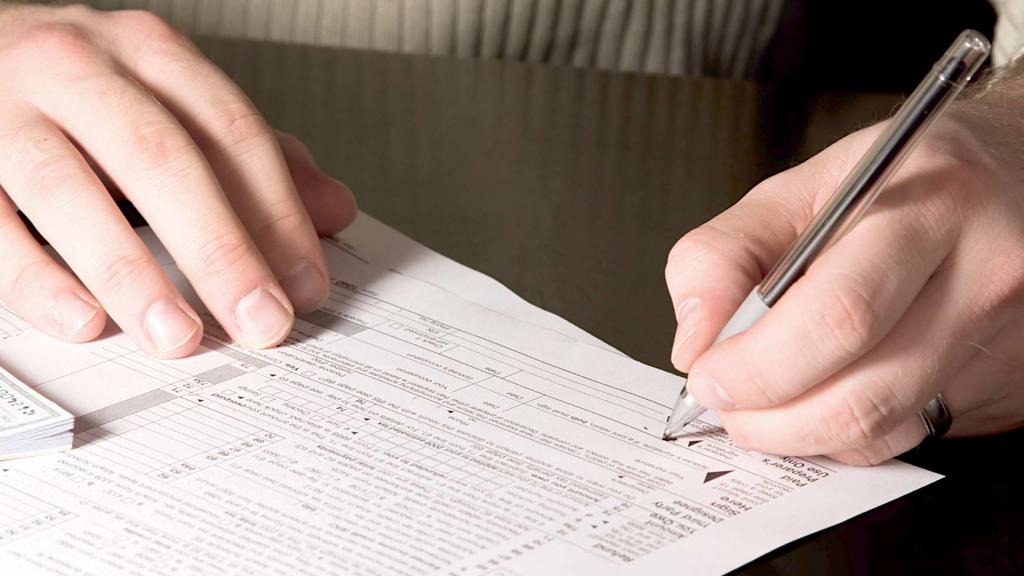By law, child support is not subject to personal income tax. This is stated in paragraph 5 of Art. 217 of the Tax Code of the Russian Federation, as well as in letters of the Ministry of Finance No. 03-04-05 / 6-1141, No. 03-04-05 / 3-276 and No. 03-04-05 / 3-274. However, in some situations there are difficulties with this issue. Also, they are in the procedure for calculating payments of the alimony payer, since it is not clear whether it is necessary to pay alimony from the tax deduction or not. Some do not understand how to calculate personal income tax when deducting child support from material gain or when the debtor uses the property deduction, is it considered such when child support is paid in favor of a minor? All these questions need to be answered.
How to calculate child support
The procedure for calculating child support is that payments are withheld only after personal income tax has been deducted. Therefore, if payments are withheld in a share rather than a fixed amount, they first calculate and deduct the tax, and withhold the alimony from the remaining amount.
If the company returns the personal income tax withheld unnecessarily, then the child support is recalculated. It turns out that alimony should be reimbursed from the amount of the return.
On income without personal income tax, the amounts indicated in the executive documents are withheld. Questions arise when there are several writ of execution. Then the accountant should adhere to the established order of debt repayment. Penalties for the maintenance of children are among the primary requirements. In addition to alimony, priority requirements include the following:
- compensation for harm to health;
- compensation for harm due to the death of the breadwinner;
- compensation for harm due to the crime;
- compensation for non-pecuniary damage.
The procedure for calculating child support implies restrictions on the amounts. The maximum amount allocated for the maintenance of minors, as a percentage, is 70% of earnings. Deductions for other purposes may not exceed 50%. If the total amount is not enough to pay off the resulting debt, the accountant distributes it among the debts in turn, proportionally for each of the executive documents.
The second part includes requirements for payment to the budget, for example, taxes. All other requirements are paid after the first two lines. In this case, you should adhere to restrictions on the size of deductions.
The following examples will help you figure this out.

Example 1
The alimony payer pays one quarter of the salary for the provision of 1 child. His monthly salary is 40 thousand rubles. The standard deduction for personal income tax for a minor is not provided. To calculate the amount of alimony, you first need to deduct personal income tax, which in this case is 5200 rubles. It turns out that the income from which alimony will be deducted is 34.8 thousand rubles. (i.e. 40 thousand - 5.2 thousand). Then ¼ income from 34,800 will be 8,700 rubles. It is this amount that is kept as alimony for the monthly maintenance of 1 child.
Example 2
The company received two executive documents for one employee, one of which concerns the maintenance of a minor child, and the other - compensation for damage resulting from an accident on the road.
In August 2018, the salary amounted to 60 thousand rubles. Subtract from this amount:
- child support for two children in the amount of one third of earnings;
- compensation for damage resulting from the accident in the amount of 40 thousand rubles.
The employee receives a standard deduction for minors in the amount of 2.8 thousand rubles.
Retention should be as follows.First, alimony is calculated, and if the remaining amount is not higher than 50 percent of the income, then deduction is made on the second writ of execution. The calculation looks like this.
- Personal income tax = 7436 rubles., I.e. (60,000 - 2800) × 13%.
- Alimony = 17 520 rub., I.e. (60,000 - 7436) × 1/3.
- Since the maximum amount of deductions is higher than the established amount, namely 26,282 rubles, that is (60,000 - 7436) × 50%, the compensation will be 8762 rubles. or 26282 - 17520.
In the following months, a similar amount is gradually paid until the damage caused by an accident is fully compensated.

Withholding tax on material benefits
The base for the accrual of alimony does not contain material benefits (obtained from the percentage savings for the use of borrowed money). Then the earnings from which payments are withheld are less than the incomes from which the personal income tax is withheld. Material benefits are taken into account only for tax purposes. It is impossible to count alimony from this income, since it exists only on paper. As a result, to determine the amount with which child support is withheld, you need to deduct only personal income tax. In the following example, it is clearly seen how this is done.
Example
Of the employee’s salary for the maintenance of 1 child, according to the writ of execution, ¼ of income is withheld. His monthly salary is 30 thousand rubles. In this case, the deduction provided to the employee is 1,400 rubles.
In 2017, he signed an interest-free loan agreement with a company where he works in the amount of 288 thousand rubles. for a period of three years, starting on January 14. Every month he must pay 8 thousand rubles as a debt payment. The question concerns not only whether it is necessary to pay child support from a tax deduction, but also how to take into account material benefits. The calculation looks like this.
The first time he returned the money at the end of February. Then income was generated in the form of financial benefits from interest savings. The current interest rate was two-thirds of the refinancing rate and was 5.5%. The following calculations were made for the month of February:
- Personal income tax = 3,718 rubles., That is (30 thousand - 1.4 thousand) × 13%);
- material benefits from January 14 to February 28 = 1996.27 rubles, that is (288 thousand × 5.5% / 365 days × 46 days);
- Personal income tax on income as a financial gain at a rate of 35 percent = 698.69 rubles. (1996.27 × 35%).
The deduction in this case does not apply.
Upon further return, the company will consider the amount of financial benefit in the same way and the tax on it in each case when paying off the debt.
- Personal income tax for February = 4417 rubles, or 3718 + 699.
- Alimony for the same month = 6570.5, or (30 thousand - 3718) × ¼.
- If we compare the alimony for this month, which were considered after tax withholding, we get: 6395.75, or (30 thousand - 3718 - 699) × 1/4.
Then the rights of the child are somewhat violated, since the alimony payer received a loan on favorable terms.

If the debtor uses a property deduction
Of particular interest is whether property tax is subject to alimony. When an employee buys housing, he has the right to take advantage of the property deduction. To do this, he needs to contact his employer and provide the necessary documents. This is usually a significant amount. So personal income tax will not be withheld from the employee for many months, and sometimes several years. Since payments for the maintenance of a minor are withheld from all income received by the employee, alimony from the property tax deduction will also be withheld.
The tax deduction is paid to the employee from the month when he informed about it. This applies to the total amount of current income. Previously withheld tax is credited against subsequent payments, as personal income tax is considered a cumulative total. However, it is not permitted to refund withheld tax until a notice is received. The amount withheld from the beginning of the year to the receipt of the relevant notice is considered to be withheld legally.
There are two algorithms for the company’s actions, how child support is calculated when applying a tax deduction at the same time. They are as follows.

1 option
If the tax deduction for a mortgage or the purchase of an apartment without a loan is less than the income calculated from the month of receipt of the notification from the tax office until the end of the year or equal to it, then the calculation may be as follows.
Recalculation for the months before receiving a notification from the tax with the aim of restoring employee income is not carried out, since in those periods the tax was withheld legally. In order to receive this tax deduction for a mortgage, the employee will apply to the tax at his residence address, having submitted a declaration in the form of 3-NDFL, as well as other required documents.
From the month that the notification arrives, and until December inclusive (with the appropriate amount of deduction), alimony is calculated from the full amount of the salary, since, thanks to the deduction, personal income tax will not be withheld.
Option 2
For a deduction that exceeds the employee’s income, from the month of receipt of the notice and until the end of the year, the calculation is performed as follows.
Alimony is calculated in the usual manner, as well as personal income tax withheld from personal income tax. And at the beginning of next year, the employee turns to the inspection at the registration address in order to receive a tax deduction for the sale of an apartment for the whole year. IFTS will not do the recalculation of alimony, which, of course, is in the hands of the alimony payer.
An employee can also receive a property deduction through an employer (this method is described in the first version). To do this, the tax authority initially needs to receive a notification.
The company should be especially careful when making settlements, as it is responsible for this financial transaction. If you do not transfer the due amount to the account of the recipient of alimony, it can be fined.
Example
According to the executive document, the amount of one fourth of the income must be calculated from the salary of the alimony payer. His salary is 100 thousand rubles. Then the income for the year will be 1.2 million rubles. A standard deduction for providing a child is not provided.
In the first 2 months of the following earnings were withheld:
- Personal income tax = 13 thousand rubles, or 100 thousand × 13%;
- child support = 21,750 rubles, or (100 thousand - 13 thousand) × 1/4.
But in March, he submitted the following documents to the accounting department:
- an application for property tax deduction for the sale of an apartment and the acquisition of another apartment;
- tax notice confirming the right to it from the amount of 1.2 million rubles.
This year, the company can calculate the employee deduction for the next 10 months, that is, in the amount of 1 million rubles. For the first two months the tax has already been withheld and will not be refunded. But to return this amount, the alimony must contact the tax office at the beginning of next year. Then he will receive the remaining amount, but the child support will not be counted.
In this regard, from March to December, personal income tax per employee will not be withheld. The tax base will be unchanged, that is, 200 thousand rubles. (for the first two months). Alimony from the tax deduction for the purchase of an apartment will be withheld from March, and will amount to 25 thousand rubles, or 100 thousand × 1/4.

Alimony payer can receive a standard deduction
For each month, the employee is provided with a deduction for the child from the beginning of the year on an accrual basis until the income reaches 280 thousand rubles, and does not exceed this amount. Its size is as follows:
- 1400 p. for the 1st child;
- 1400 p. for the 2nd child;
- 3000 p. for the 3rd and subsequent;
- 3000 p. for each, if the minor is disabled or up to 24 years old when he is full-time in a university.
One of the conditions for granting a deduction is the presence of a minor on the provision of his legal representatives, that is, his parents. If the parent has left the family, then material support is confirmed by the payment of alimony. To receive a deduction, this parent must provide the following documents:
- about the birth of a child;
- about a divorce;
- maintenance agreement, court. order or writ of execution;
- Payments confirming the transfer of alimony.
If the alimony does not fulfill his duties in accordance with the executive document, he is not entitled to claim a tax deduction.And vice versa, if he can document the payment, then this deduction is provided to him without any problems. This is because the payment of alimony is essentially participation in the mat. child support, which gives the right to receive a tax deduction. It does not matter whether the father lives with the child or not, and whether he is married to the mother or divorced.
At the same time, not every divorced father or mother listing child support can count on this deduction. So, if payments are set to a minimum amount, that is, in reality these funds are clearly not enough to provide for the child, this means that this parent does not actually participate in his material maintenance. In addition, providing a child with a citizen, but not being his parent, also does not give the right to receive this type of deduction.

Example
The employee has three children under the age of majority. Two of them are from the 1st marriage, and one from the 2nd marriage. Employee income not higher than 280 thousand rubles. In this regard, he has the right to count on a deduction from all three children, since he pays alimony in favor of three children.
Therefore, the company provides him with a deduction in the amount of 5,800 rubles: for the first two children - 1.4 thousand rubles, and 3 thousand rubles. - for the 3rd child.
Tax upon agreement
When the claimant appeals to the bailiff, the debtor has the right to conclude a settlement agreement with the alimony recipient. To approve it, you should go to court, and then provide the bailiff to cancel the coercive measures. The settlement agreement concluded within the walls of the court is the basis for the bailiff to close the enforcement case.
Then the collector should not understand whether it is necessary to pay child support from a tax deduction (property), but that the amount of child support itself will be subject to personal income tax on a general basis. The taxation of alimony exacted from executive documents is carried out in a different way. However, when approving the agreement, the funds intended for the recipient of the alimony and the amount of tax withheld should be indicated. Thus, the claimant will see the exact amount that he will receive.
Employer Responsibility
The question of whether child support is withheld from the amount of the tax deduction should be fully studied by the company's accounting department. In case of non-transfer of the amount due, the recipient of the alimony has the right to sue the court to recover the missing funds. If alimony is collected from the employer, it is he who bears the responsibility for the timely transfer of money.
Therefore, the transfer is not in full or with a delay may be considered as default. Then, the recipient of the alimony has the right to demand from the company not only the fulfillment of the obligations to transfer money in full, but also the payment of interest for each delayed day.

Conclusion
As you can see, the answer to the question of whether to pay child support from a tax deduction is not as clear as it might seem at first glance. So, if the alimony payer receives a property benefit for the purchase of an apartment in the Federal Tax Service, the amount of alimony will remain unchanged, and if at the place of work, alimony from the tax deduction will be withheld. Judicial practice also knows various cases of resolving the issue.
Ambiguous and personal income tax in the calculation of maintenance payments. For example, when concluding a settlement agreement in court, this tax will be levied on the amount of alimony. When calculating according to an executive document (agreement, court. Order or writ of execution), personal income tax is first deducted from the employee’s income, and then child support is calculated.
